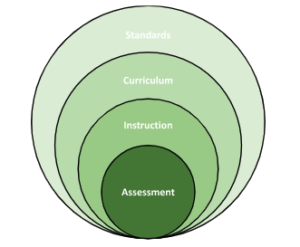November 15, 2022 / Blog
Enhancing Early Learning Outcomes Through Alignment Practices
All early childhood programs have a goal of providing opportunities for play, investigation, discovery, and problem-solving to promote positive early learning outcomes for all children. At Frog Street, we understand that the first years of a child’s life are a time of tremendous growth and development. A key component in creating positive early learning outcomes is to ensure curriculum alignment across your early childhood program. These programs should look to local, state, and program standards to guide their choices in curriculum and learning materials while informing their intentional teaching practices. In order to determine how to align curriculum to standards properly, it is important to understand what alignment is in early childhood education.
What Is Curriculum Alignment in Education?
Curriculum alignment in early childhood education is the organization of educational programs and practices in early learning settings to align with the programs and practices used in early elementary grades. Designing the basic teaching components of early learning programs to align with the developmental skills required in kindergarten and grades beyond creates continuous learning experiences and growth for children. This type of curriculum alignment is critical to achieving successful learning outcomes. Early childhood programs ensure children receive long-term benefits from this curriculum alignment process.
Alignment as a Whole
Considering curriculum alignment as a whole involves looking beyond standards and the correlations associated with those standards. Alignment as a whole includes local, state, and national standards, curriculum, instruction, and assessment.
Effective curriculum alignment in early childhood education programs is based on the following components and characteristics:
- Every early childhood program is guided by a set of standards of what children are expected to learn and accomplish. Most often these standards are created and set by states to outline the skills and competencies that children should develop by a certain age or grade.
- Programs either select or create curriculum to determine what children are actually taught. These learning experiences and content should support state and curriculum alignment standards.
- Instruction is specifically how children are taught. It is the strategies and practices used to implement curricula while providing experiences that meet children’s developmental needs.
- Assessment measures children’s progress. This data is used to inform instruction that is based on aligning curriculum to standards and measures what children have been taught.

How to Ensure Gains Through Alignment
Alignment of curriculum, instruction, and assessment is important in early childhood programs. There are best practices that support aligning curriculum to standards to ensure positive growth and development.
1. Ensure that instruction and curriculum alignment include all domains of early learning:
- Social Emotional
- Language and Literacy
- Cognitive
- Physical
2. Create curriculum, instruction, and assessments that are developmentally appropriate for each age group served.
3. Consider the individual abilities of children, and differentiate instruction as necessary.
4. Create a continuum of learning that builds on the previous stage/year.
Alignment in curriculum across all aspects of early childhood programs is important to program and child success. If done with intentionality, quality curriculum alignments can ensure early learning outcomes will continue on from early childhood education into elementary school and beyond.
